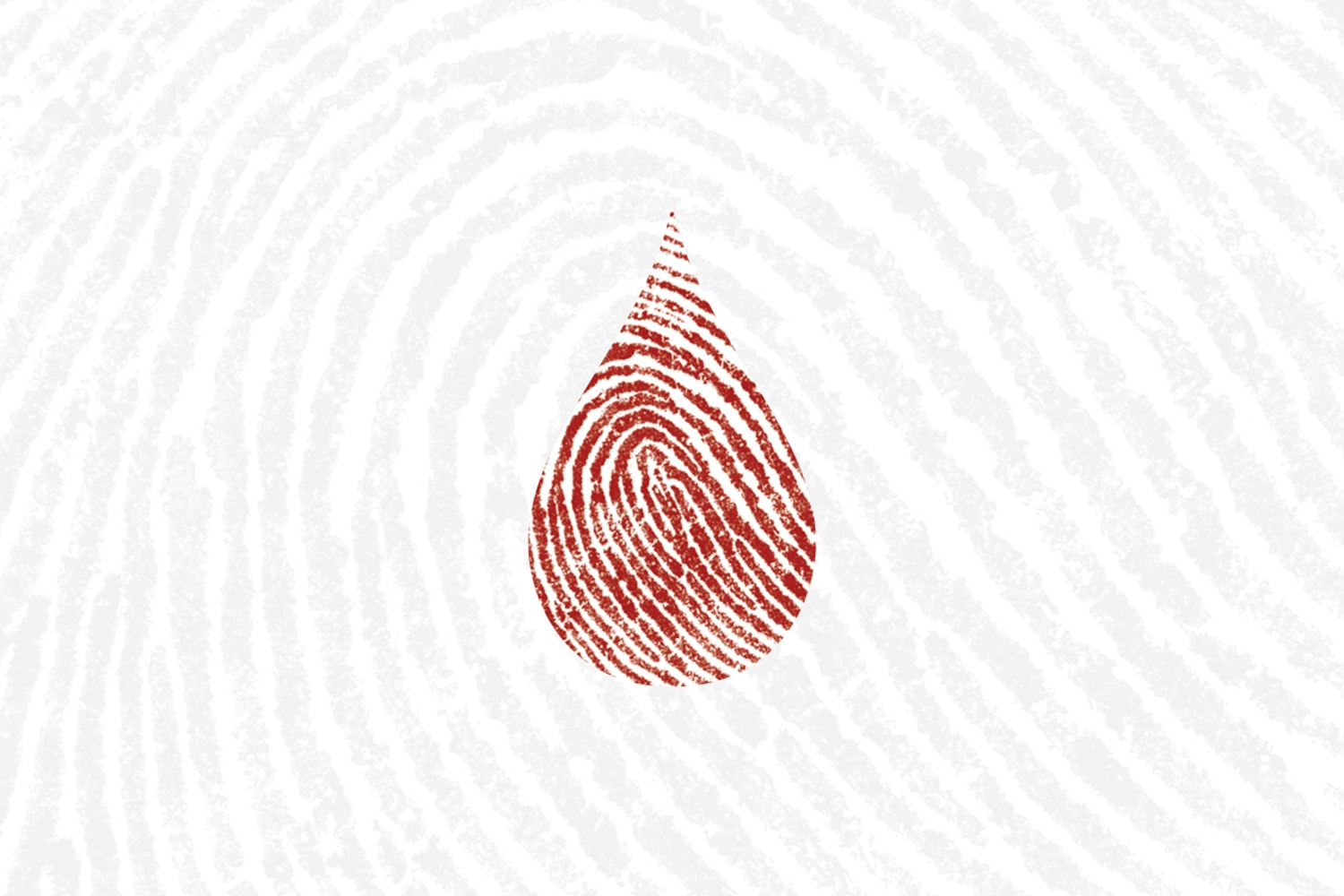ONCE A MONTH, 40-year-old Kristen Kilmer drives nearly 400 miles from her home in Spearfish, South Dakota, to the Avera Cancer Institute in Sioux Falls. On some mornings, she leaves as early as 1:30 a.m. after kissing her sleeping 11-year-old daughter goodbye. Without traffic or inclement weather, it’s a six-hour haul from one side of the state to the other.
Once there, Kilmer, who was diagnosed with metastatic breast cancer in July 2015, meets with her oncologist to discuss symptoms, medication side effects and other relevant issues. Every three months, she gets a PET-CT scan. She also provides a blood sample as part of her participation in a clinical trial to learn more about a blood test known as a liquid biopsy. It’s because of the trial—and Kilmer’s belief that liquid biopsies will ultimately help other cancer patients—that she makes the trek.
Traditional biopsies analyze tissue taken directly from a tumor and may require surgery. Liquid biopsies typically test bodily fluids to find clues about cancer. One type of liquid biopsy is a blood test that looks for cells, DNA and proteins that tumors shed into the bloodstream as they grow or spread. These biological fragments can reveal a snapshot of the state of the cancer.
A liquid biopsy “would ideally let us get an answer we could get before [with a traditional biopsy], but get it with less trouble for the patient,” says medical oncologist Jennifer Johnson at Thomas Jefferson University Hospital in Philadelphia. She notes that liquid biopsy blood tests could one day reduce the frequency of some invasive biopsy procedures and costly scans. Johnson, who specializes in treating head and neck cancers, has used blood tests developed by Foundation Medicine and also by her own pathology lab to try to uncover genetic mutations in her patients’ tumors that may be targets for drugs. She has also used the tests to track tumor progression in patients for whom a conventional biopsy is too risky, such as when a tumor sits too close to a major blood vessel.
Liquid biopsies are still at an early stage of development. So far, the tests cannot find all of a tumor’s mutations or molecular clues. In addition, no current liquid biopsy is precise enough to monitor for treatment response and cancer recurrence without validation by other tests, scans or biopsies.
Previous attempts to develop this kind of test have faced significant challenges.
The recent history of cancer diagnosis and treatment is replete with attempts to develop sophisticated blood tests to determine whether cancer is present. The ideal test would be able to identify patients with existing tumors but without symptoms. The test also would need to be reliable and not produce a lot of false positives.
In 1979, biologists identified a protein called prostate-specific antigen (PSA) in the blood of men. (It had previously been identified in semen and used in forensic investigations.) In 1986, the U.S. Food and Drug Administration (FDA) approved a test to measure PSA levels in prostate cancer patients to monitor for recurrence. In 1992, the FDA expanded the use of the test to healthy men; high levels were interpreted as an early warning sign of prostate cancer. The PSA test became a screening rite of passage for men 50 and older.
However, many organs, not just the prostate, produce PSA, and high PSA levels don’t necessarily correlate with tumor growth in the prostate. An elevated PSA level could lead to unnecessary biopsies. Even if a biopsy finds prostate cancer, it could lead to overtreatment if the cancer is a slow-growing variety that is unlikely to be harmful or cause death. For these reasons, using PSA testing to screen for prostate cancer is still controversial.
Another FDA-approved blood test for cancer measures levels of CA-125, a protein overproduced by cancers of the ovaries and fallopian tubes. At first glance, the test appeared to be an ideal tool to screen for ovarian cancer, which is often not identified until it’s at a late stage. However, CA-125 is also overproduced during menstruation and by noncancerous conditions, like uterine fibroids; the test can’t differentiate CA-125 produced by cancer from that generated by other conditions. As a result, the CA-125 test may be one tool among many used to track the progression of cancer, but is not a reliable screening tool.
A liquid biopsy for cancer screening is “one of the holy grails of cancer research,” says medical oncologist Jennifer Johnson at Thomas Jefferson University Hospital in Philadelphia. But whether this technology will be able to identify cancers reliably remains to be seen.
A Potentially Better Way
Still, liquid biopsies’ role in guiding treatment choices—by identifying a tumor’s mutations and providing information to gauge treatment effectiveness—is already starting to be realized in clinics today, says physicist Peter Kuhn of the University of Southern California in Los Angeles, who runs a lab that develops tests that analyze circulating tumor cells (CTCs) in blood. Kuhn sees the most promise in these tests’ ability to track genetic changes that can drive treatment choices, because “this is where you can actually develop a product that can indeed improve life for cancer patients.”
Several liquid biopsy tests, including FoundationAct by Foundation Medicine and Guardant360 by Guardant Health, are available to help physicians learn more about genetic alterations that could guide treatment. The Cobas EGFR Mutation Test v2 is the only liquid biopsy test approved by the U.S. Food and Drug Administration (FDA) to guide treatment. (Certain types of laboratory tests do not require FDA approval.) The Cobas test can detect EGFR mutations in the blood and is approved to be used in people with metastatic non–small cell lung cancer (NSCLC). If the blood test reveals an EGFR mutation, the patient may benefit from a class of drugs called tyrosine kinase inhibitors. If the Cobas liquid biopsy comes up negative for an EGFR mutation, however, the FDA advises that patients undergo a tumor tissue biopsy to confirm the findings.
Researchers at Memorial Sloan Kettering Cancer Center in New York City and Epic Sciences in San Diego also developed a test. The Oncotype DX AR-V7 Nucleus Detect, which is offered through Genomic Health, identifies a protein called AR-V7 in the CTCs of men with castration-resistant metastatic prostate cancer. The test can help determine which of these men have resistance to treatments that target hormone pathways so they can go straight to treatment with taxane chemotherapy.
Making Decisions
Kilmer, who works in marketing and public relations at Black Hills State University in Spearfish, joined a clinical trial for liquid biopsies because she wanted to contribute to research. Patients in the study provide blood biopsy samples to help scientists learn more about the molecular drivers of cancer. Kilmer’s results, along with her symptoms, influenced her treatment.
She was initially diagnosed with hormone-receptor positive, stage IIB breast cancer in September 2011. She went into remission after treatment at the Regional Health-John T. Vucurevich Cancer Care Institute in Rapid City, South Dakota, that included a double mastectomy, chemotherapy and radiation. She also took tamoxifen for three years to try to keep the cancer from coming back.
In May of 2015, Kilmer noticed swelling in her neck. After scans and a tissue biopsy revealed that her cancer had metastasized, her oncologist prescribed Ibrance (palbociclib), a targeted drug for metastatic hormone-receptor positive disease, and Femara (letrozole), an aromatase inhibitor. Her doctor also sent her tumor sample to Foundation Medicine. After the test revealed a mutation in the mTOR pathway, Kilmer switched to Avera Cancer Institute for treatment in September 2015. Her oncologist there added Afinitor (everolimus), an mTOR inhibitor. The goal, Kilmer says, was to block as many cancer pathways as possible. Her scans have shown no evidence of disease since then.
Kilmer had her first liquid biopsy as part of the clinical trial in January 2016. Four months later, in May, her liquid biopsy showed a mutation linked to resistance to Ibrance. Her biopsy that August revealed increases in the same mutation. By September, she began experiencing lymphedema, or swelling, in one arm and an uncomfortable pressure in her chest.
At that point, Kilmer says, she and her oncologist had to make a decision. “Do we watch it longer, or do we try to get on top of it?” Kilmer asked. Despite her clean scans, they decided to act. Kilmer switched to Votrient (pazopanib), a tyrosine kinase inhibitor. It was like flipping a switch, she says. “Within just a few days, the swelling started to go away.” So did the pressure in her chest.
Subsequent liquid biopsies have shown no signs of that mutation. (Because of side effects from Votrient, however, Kilmer switched drugs in September 2017 to Lynparza [olaparib], a PARP inhibitor that targets a mutation identified in an earlier tissue biopsy.) Kilmer and her oncologist don’t know if they managed to avoid a cancer recurrence, but she says the change in medication did improve her symptoms.
With so much about liquid biopsies still unknown, traditional molecular analysis using tumor tissue remains a mainstay. John Nissim, who is retired and lives in Philadelphia, was diagnosed with stage IV NSCLC in November 2014. He underwent a tissue biopsy of a tumor in his spine and learned that the tumor had what’s called a “classical” EGFR mutation. These tumors can often be successfully controlled with tyrosine kinase inhibitors. After Nissim received radiation, his oncologist prescribed Tarceva (erlotinib). He also had two liquid biopsies, but they didn’t reveal any new information.
In October 2017, a biopsy of cancerous adrenal tissue revealed an additional mutation in the EGFR gene, called T790M, which wasn’t detected in the liquid biopsies. The mutation suggested that Nissim could have been developing resistance to Tarceva. In December 2017, he switched to Tagrisso (osimertinib), another tyrosine kinase inhibitor.
Improving the Science
Scientists are looking for ways to make liquid biopsies more precise so they can be used more regularly for monitoring disease progression. Jerry S.H. Lee, a chemical engineer and the health sciences director at the National Cancer Institute in Bethesda, Maryland, develops programs aimed at using new technologies to help improve effective cancer interventions. He notes that blood sample results depend on a staggering range of factors, such as differences in patients’ weight or whether “a patient is taking drugs like anticoagulants that change the composition of blood. It’s not static, like tissue.” This leads to variability in samples. “At any given moment, you’re hoping that what you just pulled out is representative” of how the cancer is progressing, he says.
The human body constantly processes and breaks down DNA—from both normally functioning cells and cancerous ones. Each blood sample may not contain every mutation in a cancer tumor. And even though liquid biopsies can detect many mutations—the Cobas test identifies 42—the importance of all those mutations in cancer progression isn’t always clear, making liquid biopsies imprecise tools for now.
Researchers are trying to speed up the development of clinically useful liquid biopsies through collaboration. For example, the National Cancer Moonshot Initiative, which was led by former U.S. Vice President Joe Biden, spurred the development of the Blood Profiling Atlas in Cancer, or BLOODPAC. This nonprofit, data-sharing collaboration brings pharmaceutical companies and academic researchers together to share their research on liquid biopsies.
Real-World Challenges
In the meantime, headlines that hype liquid biopsies as a quick way to assess a person’s cancer can lead to false hope, Kuhn says. “We have to set expectations with patients. That’s a real challenge.”
When Johnson treats her patients at Thomas Jefferson University Hospital in Philadelphia, she is careful to explain that the test may not reveal any new or actionable information, but that in some cases it could suggest a potential treatment or clinical trial.
“We have a pretty frank discussion of the pluses and minuses of doing it,” she says. Cost is also a factor. For example, the list price per test for FoundationAct is $5,800, and Guardant360 costs $7,800 per test. Nissim’s first liquid biopsy was covered by a foundation that sponsored development of the test. He says he was billed $2,400 for the second test, but his insurance company worked with the company that made the test to lower the bill. Johnson says she encourages patients to enroll in clinical trials that might cover the cost of the test.
Medicare currently reimburses patients for medical interventions that have been proven to extend survival. Most liquid biopsy research has yet to prove that the tests can meet that standard. In addition, insurance companies may not cover the cost of liquid biopsies used to monitor for treatment response. Kilmer and Nissim say their health care providers warned them about the uncertainties of liquid biopsies, but Kilmer wanted to explore every possible option, including experimental ones.
“I would encourage having the test done if you can find a way to pay for it or a trial to enter into,” she says. But she cautions that the test results may be disappointing. “There is no guarantee that it will provide any guidance for curing your cancer.”
Cancer Today magazine is free to cancer patients, survivors and caregivers who live in the U.S. Subscribe here to receive four issues per year.





